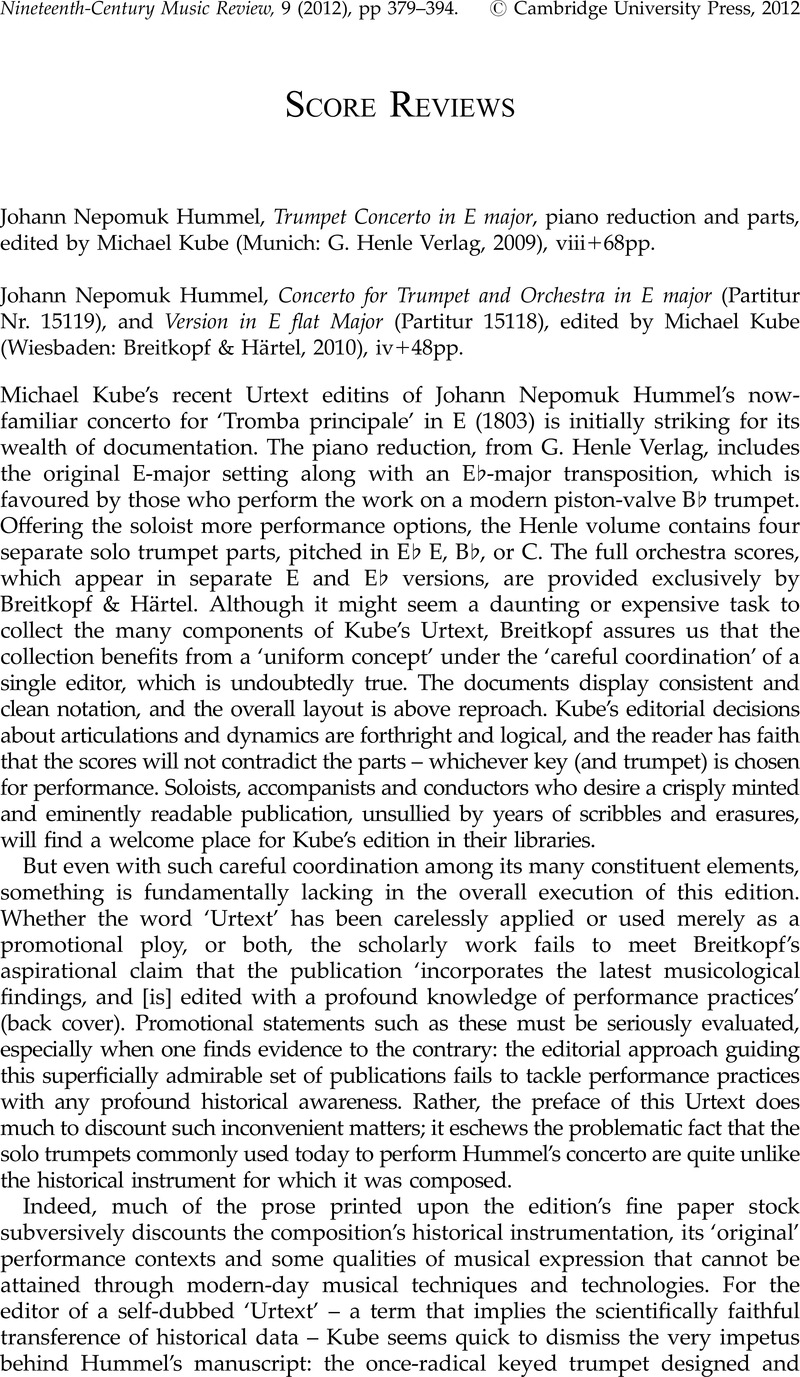No CrossRef data available.
Article contents
Johann Nepomuk Hummel, Trumpet Concerto in E major, piano reduction and parts, edited by Michael Kube (Munich: G. Henle Verlag, 2009), viii+68pp. - Johann Nepomuk Hummel, Concerto for Trumpet and Orchestra in E major (Partitur Nr. 15119), and Version in E flat Major (Partitur 15118), edited by Michael Kube (Wiesbaden: Breitkopf & Härtel, 2010), iv+48pp.
Published online by Cambridge University Press: 08 January 2013
Abstract

- Type
- Score Reviews
- Information
- Copyright
- Copyright © Cambridge University Press 2012
References
1 Schilling's encyclopedia placed Weidinger among the last natural-trumpet virtuosos of the nineteenth century. See ‘Trompete’, in Gustav Schilling, Encyclopädie der gesammten musikalischen Wissenschaften: oder Universal-Lexicon der Tonkunst, vol. VI (Stuttgart: Köhler, 1840): 693–6.
2 See ‘Ueber die neurlichen Verbesserungen der Trompete, und der ihr ähnlichen Blasinstrumente’, Allgemeine musikalische Zeitung, no. 38 (20 September 1815): cols. 633–8.
3 See Yamaha Corporation, ‘Custom E / E♭ Heavy Wall Trumpet’, http://usa.yamaha.com/products/musical-instruments/winds/trumpets/eeb-trumpets/ytr-9635, accessed 23 March, 2012.
4 William Morrow, ‘The Trumpet as an Orchestral Instrument’, in Proceedings of the Musical Association xxi (1894–5): 140.
5 Wisely, Kube does not claim improved intonation through valve trumpets, because nearly every note requires the performer to consider a slide adjustment or an alternate fingering in order to play ‘in tune’ with other instruments, especially the equal-tempered piano. At the end of the nineteenth century, one of Morrow's colleagues in the British Musical Association admitted, ‘No valve instrument can be constructed to give the tempered scale accurately,’ and that many manipulations are required to retain the ‘characteristic sweetness’ heard in the natural trumpet's ‘true intervals.’ Morrow, ‘Trumpet as an Orchestral Instrument’, 146.
6 Ralph Dudgeon, The Keyed Bugle, second edition (Lanham, MD: Scarecrow Press, 2004)Google Scholar
7 Felix Mendelssohn-Bartholdy, Sämtliche Briefe, Bd. 2 (Kassel & New York: Bärenreiter, c 2008)Google Scholar
8 Schubart, Christian Friedrich Daniel, Ideen Zu Einer Ästhetik Der Tonkunst (Vienna, 1806), ed. Fritz Kaiser, Margrit Kaiser and Ludwig Albrecht Schubart (Hildesheim: G. Olms, 1990): 309–310Google Scholar
9 Adolph Bernhard Marx, The Music of the Nineteenth Century and Its Culture (London: Robert Cocks and Co. [1854])Google Scholar
10 Ibid., 69.
11 Ibid., 70.
12 Elson, Arthur, Orchestral Instruments and Their Use: Giving a Description of Each Instrument Now Employed By Civilised Nations (Boston: L.C. Page & Co., 1903): 229Google Scholar
13 Marx, The Music of the Nineteenth Century, 71Google Scholar
14 Hipkins, A.J., ‘Musical Instruments: Their Construction and Capabilities’, Journal of the Society of Arts xxxix (7 Aug, 1891): 758Google Scholar
15 Morrow, ‘The Trumpet as an Orchestral Instrument’, 139Google Scholar
16 Student trumpeters who cannot afford Henle's volume can visit 〈http://la.trompette.free.fr〉 for serviceable solo parts in different keys.


